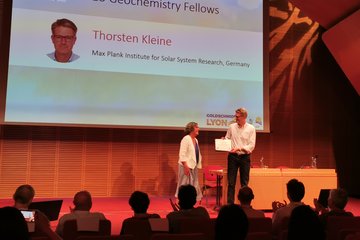Alle Typen
201.
Konferenzbeitrag
Statistical properties of magnetic fields in intranetwork. In: SOLMAG 2002, Proceedings of the Magnetic Coupling of the Solar Atmosphere, Euroconference and IAU Colloquium 188,, S. 445 - 448 (Hg. Sawaya-Lacoste, H.). ESA Publications Division, Noordwijk, The Netherlands (2002)
202.
Konferenzbeitrag
Inversion of 1.5 μm spectral data of a sunspot. In: Proc. ``Probing the Sun with High Resolution'' (Hg. Venkatkrishnan, S.; Tripathy, S. C.; Venkatkrishnan, P. V.). Alpha Science, Pangbourne (2002)
203.
Konferenzbeitrag
Thermal-magnetic relation of a sunspot from the inversion of IR spectral data. In: 1st Potsdam Thinkshop on Sunspots and Starspots Poster Proceedings, S. 117 - 118 (Hg. Strassmeier, K. G.; Washuettl, A.). Brandenburgische Universitätsdruckerei, Golm (2002)
204.
Konferenzbeitrag
Thermal-magnetic relation of a sunspot as inferred from inversion of 1.5 μm spectral data. In: SOLMAG 2002, Proceedings of the Magnetic Coupling of the Solar Atmosphere, Euroconference and IAU Colloquium 188,, S. 501 - 504 (Hg. Sawaya-Lacoste, H.). ESA Publ. Div., Noordwijk (2002)
205.
Konferenzbeitrag
The Energetic Particles Detector (EPD) Aboard the Galileo Spacecraft. In: The Three Galileos: The Man, the Spacecraft, the Telescope, S. 319 - 330 (Hg. Barbieri; C.; others). Kluwer, Dordrecht (1997)
206.
Vortrag
Science with Sunrise III. Kolloquium am Leibniz Institut für Sonnenphysik, Freiburg, Germany (2021)
207.
Vortrag
SUNRISE III: High-resolution exploration of the solar atmospheric stratification. Virtual Annual Meeting of the Astronomische Gesellschaft 2020 (2020)
208.
Vortrag
Sunrise -3: High-resolution exploration of the solar atmospheric stratification. 5th Asia Pacific Solar Physics Conference, Pune, India (2020)
209.
Vortrag
European Solar Telescope: Recent Progress. 5th Asia Pacific Solar Physics Conference, Pune, India (2020)
210.
Vortrag
Sunrise-III: a plasma physics
laboratory for the Sun. Max Planck Princeton Center - Workshop, Göttingen, Germany (2020)
211.
Vortrag
SUNRISE-3: a close-up view of the Sun
from a stratospheric balloon. Annual Meeting of the German Astronomical Society: “Mission to the Universe: From Earth to Planets, Stars & Galaxies"
, Stuttgart, Germany (2019)
212.
Vortrag
SUNRISE - a stratospheric solar observatory. HEMERA summer school, Heidelberg, Germany (2019)
213.
Vortrag
Sunrise-3: Three High-Resolution Solar Spectro-Polarimeters in the Stratosphere. Solar Polarization Workshop 9, Göttingen, Germany (2019)
214.
Vortrag
Relating the magnetic field strength with the umbra-penumbra boundary in sunspots. SolarPolarization Workshop 9, Göttingen, Germany (2019)
215.
Vortrag
Getting ready for the 3rd science flight of Sunrise. 24th ESA Symposium on European Rocket and Balloon Programmes and Related Research, Essen, Germany (2019)
216.
Vortrag
Towards better Vector Magnetic Field Maps for Helicity Observations. Solar Helicities in Theory and Observations: Implications for Space Weather and Dynamo Theory, Stockholm, Schweden (2019)
217.
Vortrag
Inversions and the Chromospheric Magnetic Field. SAMI18, Göttingen, Germany (2018)
218.
Vortrag
A new method for measuring the Wilson depression of sunspots. Hinode - 12 The many Suns, Granada, Spain (2018)
219.
Vortrag
Magnetic fields in the chromosphere. IRIS-9 Workshop, Göttingen (2018)
220.
Vortrag
GRISPlus am GREGOR: was ist das, und wozu braucht man das? Observatorio del Teide Technical Meeting 17, Staufen (2018)











